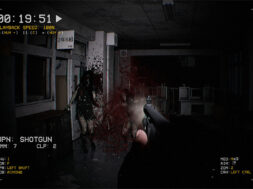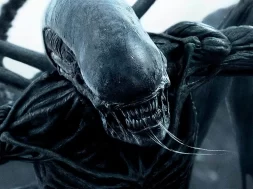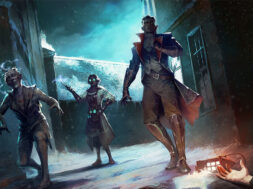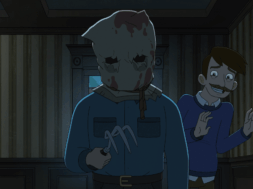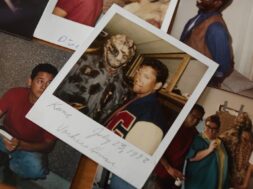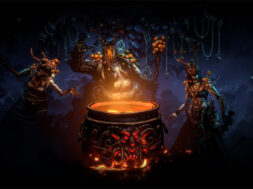Herschell Gordon Lewis earned the moniker “godfather of gore” in the early ‘60s when he created the splatter subgenre in horror with Blood Feast. But it didn’t take long before another director would earn and share the title; Italian maestro Lucio Fulci. Fulci began his film career as a documentary director before switching gears and shifting into comedy screenwriting. The screenwriting eventually gave way to producing, acting, and directing feature films. With an extensive career that spanned almost five decades, Fulci dabbled in all genres, from spaghetti western to musicals to exploitation, but it was his work in horror that earned him international success.
Fulci earned notoriety in his home country of Italy in the ‘70s due to the graphic violence depicted in his giallo films. The graphic violence and gore would become his trademark with the international breakthrough hit Zombi 2, or Zombie. Of course, the gore meant his work often ran afoul with censors and critics, and as a result Fulci’s horror filmography took much longer to reach classic reevaluation than the likes of Mario Bava and Dario Argento. It wasn’t just his use of gore that makes Fulci a vital pillar of Italian cinema, but his ability to craft atmosphere. Fulci’s work is fearless and with a distinct style that earned him a massive following from the horror community. You could count on Fulci to be unafraid to push the boundaries of bad taste. Moreover, Fulci’s horror films have played a major influence on American filmmakers, and still continues to inspire today. Though his lengthy catalog is full of films worth seeking out, these five horror classics are his most influential.
Zombie

Also known as Zombi 2, this beloved zombie film was intended to serve as a sequel to George A. Romero’s Dawn of the Dead (Zombi in Italy). Fulci was hired for the project based on his work in his giallo The Psychic, and it changed the trajectory of his career. Though he never set out to be a horror director, the international success found in Zombie paved the way for his most widely adored “Gates of Hell” trilogy. The gore put this film in the crosshairs of the Video Nasty craze, and marked a trend in Fulci’s affinity for ocular trauma. In a way, Zombie serves as inspiration for Fulci’s future work in horror. But on a bigger scale, Zombie directly influenced the work of filmmakers like Quentin Tarantino, who mimicked shots straight from the film for his own film Kill Bill: Volume 1.
A Cat in the Brain

One of the director’s final films, released in 1990, A Cat in the Brain also happens to be one of his most personal films. In addition to co-writing and directing, Fulci stars as himself. It’s a meta film in which Fulci plays a filmmaker-driven made by his experiences behind the camera of his goriest films. Fulci assembled much of the film from clips of his previous horror films, and as such wasn’t a favorite among fans upon release. But his health was fading during production and A Cat in the Brain was reflective of his depression. It was also his response to the criticisms he’d received for much of his work in horror. As for its influence, this film was ahead of the curve in terms of the wave of meta-horror that would follow in the latter half of the decade.
Don’t Torture a Duckling

Though Zombie was the film that really revved up Fulci’s use of gore, it began with this giallo. A remote Southern town is plagued by a string of child murders, and a reporter and a promiscuous woman team up to discover who’s responsible. The problem is that the town is superstitious and mistrustful of outsiders. Heavily themed around repression and guilt, the film’s hefty criticisms of the Catholic Church meant the film was essentially blacklisted for a period. It was the earlier stages of Fulci’s experimentation with close up violence, and a giallo that leaned into the political. As such, it’s a film that played major influence on filmmakers like Tarantino and French husband-and-wife team Hélène Cattet and Bruno Forzani (Let the Corpses Tan).
The House by the Cemetery

The final entry in the “Gates of Hell” trilogy is also the only one that doesn’t have that same dreamlike quality that its predecessors had, and it’s smaller in scope. The plot follows a family who recently move into a New England home that’s been host to a series of murders in the past, unaware of the dark secret lurking in the basement. Does that plot sound familiar? Ted Geoghegan’s 2015 feature debut, We Are Still Here, draws inspiration from many films, but at its core is a heartfelt homage to Fulci and The House by the Cemetery. It’s not just the story in which Geoghegan drew inspiration, but the characters’ names as well.
The Beyond

Easily the most celebrated among Fulci’s horror films, and the second entry in his unofficial “Gates of Hell” trilogy, The Beyond also is the director’s most influential. Set in Louisiana, a young woman inherits a hotel and discovers it was built over one of the gates to Hell. Bleak, surreal, and dreamlike in its storytelling, The Beyond toes the line between beauty and horror. Essentially, The Beyond is what happens when you cross Fulci with H.P. Lovecraft. That it played a vital influence for Tarantino is no surprise at this point, but it also inspired notable directors like Sam Raimi, who lifted a shot from The Beyond when creating Spider-Man. Even horror films as recent as last year’s The Void pay homage to this Fulci classic.
